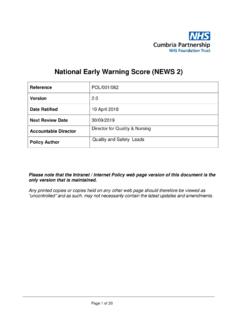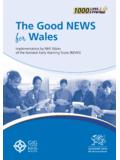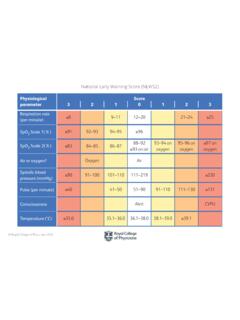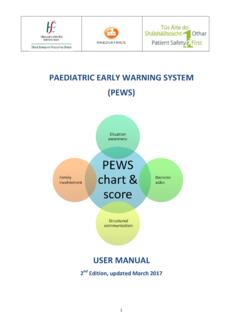Transcription of Early Warning Signs of Autism Spectrum Disorder
1 Early Warning Signs of Autism Spectrum Disorder Endorsed by the American Academy of Pediatrics and the Society of Developmental and Behavioral Pediatrics Developed in partnership with Health Resources and Services Administration Maternal and Child Health Bureau Early Warning Signs of Autism Spectrum Disorder Abstract At a family function, your cousin asks your advice about the development of her 2-year-old son. She has noticed that he has a hard time communicating, is rigid in his behavior, and often has temper tantrums. Her pediatrician does not seem very concerned, but she wants your opinion given that you are working in pediatrics. Case Goal Early Warning Signs alert providers to the risk of a possible Autism Spectrum Disorder (ASD).
2 Recognizing these Warning Signs is necessary in order to know when to screen or further evaluate children for ASD and how to appropriately counsel families. After completion of this module, learners will be able to: 1. Identify key social-emotional and language milestones through 24 months of age 2. Recognize the major Early Warning Signs of ASD. Three Steps to Prepare - In 15 Minutes or Less! 1 Read through the Facilitator's Guide and make copies of the case and learner worksheet for distribution. 2 Identify the key topics you wish to address. Consider: - Knowledge level of learners - Available time - Your familiarity with the subject 3 Select and prepare the optional teaching tools you wish to use.
3 Each case provides a variety of optional materials to enhance the learning environment, support facilitator style, focus on different themes, or accommodate different time limitations. These materials are optional for facilitators to use at their discretion. - Handouts: select any you wish to use and make copies for distribution - PowerPoint: decide if you wish to use and confirm necessary technical equipment - Video: review embedded video and video library, decide if you wish to use, confirm necessary technical equipment, and conduct test run The following case was developed by the authors. It Developed in partnership with does not necessarily reflect the views or policies of the Health Resources and Services Administration Department of Health and Human Services (HHS) or the Centers for Disease Control and Prevention (CDC).
4 Maternal and Child Health Bureau. 1. Autism Case Training: A Developmental-Behavioral Pediatrics Curriculum Early Warning Signs of Autism Spectrum Disorder Key Learning Points of This Case 1. Identify key social-emotional and language milestones through 24 months of age a. Describe typical social skills that are present in children from birth through 24 months ( and Handout I: First Signs Hallmark Developmental Milestones). b. Identify expected language milestones from birth through 24 months (Prompt and Handout III: Your Child at 2 Years). c. Identify expected play skills by age (Prompt and Handout V: Play Skills). 2. Recognize the major Early Warning Signs of ASD. a. Identify key red flags for ASD (Prompt and Handout VI: Red Flags of ASD).
5 B. Recognize the difference between a typical temper tantrum and one of a child with an ASD (Handout IV: Temper Tantrums). Only Have 30 Minutes to Teach? :30. Focus your discussion on recognizing typical and atypical behavior and development, particularly social and play milestones, as well as the red flags of ASD. Use: Handouts: III Your Child at 2 Years and VI Red Flags of ASD. Videos: Response to Name and Nathan & Ben Playing . Potential Prompts: and Materials Provided Case Worksheet for Learners The Case Study: Part I, II, and III (available in Facilitator's Guide and on CD). Optional Teaching Tools PowerPoint with Embedded Videos (available on CD). Handouts (available in Facilitator's Guide and on CD).
6 Handout I: First Signs Hallmark Developmental Milestones Handout II: Shy Temperament vs. ASD. Handout III: Your Child at 2 Years Handout IV: Temper Tantrums Handout V: Play Skills by Age Handout VI: Red Flags of Autism Spectrum Disorders Video Library (available on CD)*. References *There are many potential videos for this case in the video library that demonstrate red flags and milestones. Please review the library for additional videos. Case Authors Liz Harstad, MD, Children's Hospital Boston, Harvard Medical School Carol Baum, MD, Warren Alpert Medical School of Brown University Yvette Yatchmink, MD, PhD, Warren Alpert Medical School of Brown University Editors Georgina Peacock, MD, MPH, National Center on Birth Defects and Developmental Disabilities, Centers for Disease Control and Prevention Carol Weitzman, MD, Yale University School of Medicine Jana Thomas, MPA, Porter Novelli 2.
7 Autism Case Training: A Developmental-Behavioral Pediatrics Curriculum Early Warning Signs of Autism Spectrum Disorder Getting Started This case is designed to be an interactive discussion of a scenario residents may encounter in their practices. Participation and discussion are essential to a complete learning experience. This Facilitator's Guide provides potential prompts, suggestions for directing the discussion, and ideas for incorporating the optional teaching tools. It is not designed as a lecture. Case study icons: Early Warning Signs of Autism Spectrum Disorders Case Study Part I Distribute Case Study Part I . You are attending a family reunion and during a quiet moment, your cousin Elizabeth takes you aside and asks you what you think about the development of her son, Mark.
8 Call-out: step-by-step teaching instructions She tears up as she tells you how worried she is about him. Mark will be 2 years old next month, and he seems so different from the other children on the playground. Although he Slide 3. is an affectionate and happy little boy, his behaviors can be so unpredictable. He is very shy and has terrible temper tantrums. It is usually impossible to reason with him. Small changes in his routine throw Mark off, and Elizabeth is worried that he won't be able to handle the crowd at this family gathering without causing a scene. You ask her what her pediatrician thinks. Elizabeth tells you that Mark has been seen by his pediatrician, and she has expressed Note: tips and clarification her concerns about his temper tantrums on a few visits.
9 Mark enjoys going to the doctor's office because they have a large tropical fish tank, and he has generally been calm in that setting. Mark's doctors have all been very reassuring, and think he has a bad case of the terrible twos. The doctor has told her to give him some time; he is still young and will likely grow out of this phase.. You have been preoccupied by your relatives, and you honestly haven't been paying too much attention to Mark. You know that your cousin is a doting and caring mother. Elizabeth and her husband, Sam, had fertility struggles, and she was thrilled to give birth to Mark after a grueling course of in-vitro fertilization treatments. You know that Mark was Slide: optional slide, if using PowerPoint born full term without any complications.
10 You heard that he was a fussy baby, but that he was otherwise healthy. Case Study Part I: Discussion Question Slide 4. After reading the case, ask participants, What stands out to you about the Filmstrip: optional slide contains an embedded video mother's concerns? . Follow up with student responses Case Study Part I: Potential Prompts to encourage more discussion: What are some key developmental milestones for ages 6 months to 4 years? What in the case supports that? Why do you It is evident that Elizabeth is concerned about Mark's shy manner. What are typical think that? social skills that most children obtain by 12 months? By 18 months? By 24 months? Paper: potential place to distribute an optional handout What makes you say that?















